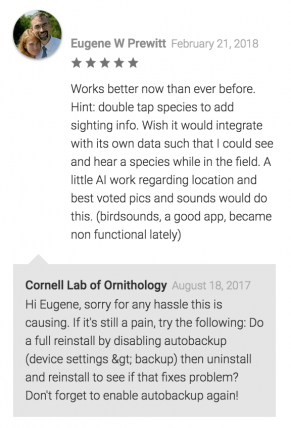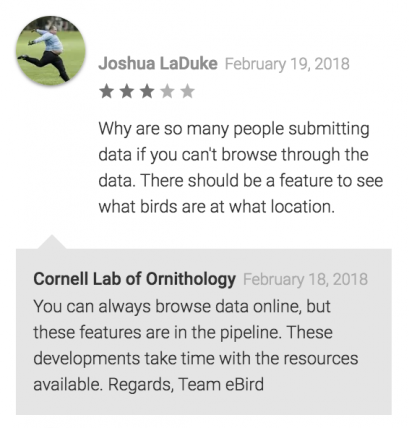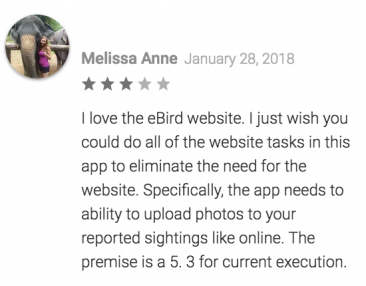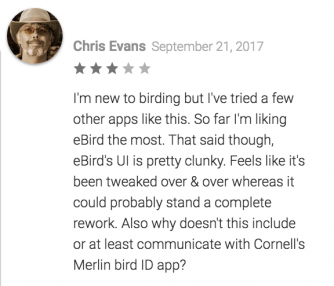Think Exercise: Bird Counting app notes
Client meeting
- Design starts during your first interaction with the client
- What is the problem they've identified?
- What are the project constraints?
- Budget?
- Timeline?
- This could determine whether I'd be able to attend a bird watch myself, or just rely on watching videos online and asking people.
- What are the prioritized outcomes? Accuracy? Returning bird watchers who want to help grow the community? Fun?
- Who is the client deep down? What is their business model? Which way are they heading?
A novice's perspective
- I don't know anything about bird-watching, and that's a temporary advantage. For a precious few hours, I'm the target user of this app preparing for my first bird count. My brain is a clean slate.
- I don't know how a bird count usually goes, let alone how I could improve a bird-watching app to make it better.
- My preliminary questions:
- Who goes bird-watching? Older people? Kids?
- Who would use this app? Everyone? Just the group leader?
- How many bird species are expected to be in my designated area? Under 20? Over 100?
- Could I encounter unexpected bird species for the region? Do they also need to be counted?
- How do bird watchers prefer to count? Do they already use an app? Pencil and paper? Would they ever consider using an app?
- Would gloves in cold weather make them reluctant to use an app?
- How do bird watchers figure out which bird they've found? Paper field guides? Apps?
- Where do bird watches occur? In the woods? In cites? I'm guessing anywhere?
Establishing the problem/goal
The design of the app will and should be a direct reflection of Audobon's intent and future plans. Depending on the problems or goals they identify, the primary "call to action" of the app may be very different.
- "Attendance is decreasing each year and we think having a smartphone app would help kids get more interested"
- Many assumptions are made here
- "We've gotten a lot of requests from birders that they'd prefer to use an app during the bird count rather than the paper and pencil system we use currently"
- How many requests relative to the total number of birders?
- Does it have to be an app? Could it be a web app?
- Do they have the technical ability to create and sustain both iOS and Android apps?
- "Birders often mis-identify birds"
- "We want to enable birders to collect data at home, even if they're first-timers"
Research
- What does the client want, deep down? They want an "app" but there may be underlying assumptions, so I need to dig into that and maybe project into the future to align the app with their goals.
- I can't easily talk to birders directly, but I can read about their experiences
- I should read articles, search for other apps, read forum discussions from watchers about issues they experience, etc.
- Artifacts
- Personas
- Competitive analysis
- User goals and needs
Client research
- Audobon 2016-2020 Strategic Plan (PDF version)
- Page 16 - Maximizing our Impact
- $60M to $71M budgeted for their plans in various categories
- Page 50 - Technology and Communications
- "Put our credibility first in all of our communications."
- "Invest in ways that connect people with Audubon through compelling content, shared experiences, and rewarding relationships. Whether those are new apps or a constantly improving Web presence, we will tell the stories of birds and the people who care about them to inspire, recognize, and honor those efforts."
- "The Bottom Line: We’ll put an additional $9-11 million a year to work on technology and communications"
- Intent to create a "best-in-class" website and journalistically excellent magazine.
- "... more than a million social media users as of 2016"
- They collaborate with Esri for mapping data, visualization, and monitoring
- Page 16 - Maximizing our Impact
- Wikipedia
- National Audobon Society
- eBird is a collaboration between Cornell's Lab of Ornithology and Audobon
- 24 state offices, 500 local chapters, international collaborations
- They produce Audobon field guides with actual photos, with 18M copies sold
- Christmas Bird Count
- Started as a hunt, became a count in 1900,
- 250 bird species in one location is the highest number recorded
- National Audobon Society
Web review
- Official Audobon.org
- Active circle map
- Compiler Resources list
- How it works
- Each count takes place in a 15-mile circle
- A circle/count compiler organizes each circle
- Volunteers follow specified routes and count every bird they see or hear that day
- Beginners are paired with groups that include one experienced watcher
- Volunteers can arrange to stay at home and report birds that visit their feeder (presumably with a group)
- Single-observer counts are not allowed - volunteers must coordinate with a circle
- Not all circles can be registered for online, possibly because they're already filled
- Participants' guide on what data to collect during your Christmas Bird Count
- Cover your assigned route as thoroughly as possible during the daylight hours
- Record all hours spent watching, traveling, miles traveled, and mode of transport while watching/listening
- Record hours watching at feeders separately from the field
- Record hours/miles "owling" separately from the field during the day
- Compilers' manual to CBC
- Compiler basics
- 8 hours of daylight coverage with 10 observers is recommended for adequate coverage
- Voice ID'ing is okay, but specimens or tracks are only able to mark a species as "present" or "cw" (count week) during the count week period (3 days before, 3 days after the count day) - numbers must be observed during the count day
- One primary circle contact must provide their name, address, email and phone to the CBC website when creating their circle
- Compiler's role
- Recruit and remind participants in early November
- Remind people to bring binoculars, food/water, footwear, rules, meetup spot
- Participants can upload photos to the online CBC photo gallery website
- Participants should follow the same route each season to master the area
- "Census route" is one route covered in-depth for historical purposes
- Hours spent, distance traveled, and counter totals are considered "Effort Data" that help researchers determine thoroughness
- Feeder-watchers should count the highest number of each species visible/hearable at one point in time as their "maximum count"
- If a "large roost" is spotted within the circle, an experienced observer should estimate the number and individuals are not counted before or after
- Playing attractant audio is allowed but must be done consistently and not overbearingly
- Details to record
- Temperature
- Wind direction and velocity
- Snow depth min/max
- Water ice coverage
- Cloud cover (am/pm)
- Rain/snow (am/pm)
- Party hours & distance
- "In Field" parties
- "At Feeder" parties (as in, people who ONLY sat at feeders for many hours during one day) are counted entirely separately
- Nocturnal birding or "owling" is the number of hours spent in the field during non-daylight hours, and their data is also kept entirely separate
- "Unusual" birds are at the discretion of a regional editor
- Total number of species observed
- Compiler basics
- Compilers' guide to CBC party miles and hours
- Miles driven by party is not multiplied by the number of party members - they're treated as one unit
- Time spent observing feeders by field parties is not lumped into the data for designated feeder-watchers - this allows papers like this one to separate out feeder-watcher-reported data
- History of the Christmas Bird Count
- Started as a hunting competition, transitioned to a database
- Plenty of videos of different regions and people
- Helps researchers quantify irruptions (mass movement of a species to places they're not usually seen in search of food during the winter, particularly after a successful breeding season) and general population changes
- Birding in Philly’s Forgotten Habitats
- Ring-necked pheasants have vanished from Philly in the last 40 years
- 72 participants in 2017 counted in the less "glamorous" spots of Philly
- ~100 species in the region
- The Christmas Bird Count: The longest running citizen science project in the world
- Some common species from his childhood have since left, and the data allows hunches to be backed up with data
- Conducted in the winter partially because it's a peak migration time
- News articles
- Greenwich, Stamford birders find 104 species during Christmas bird count
- Roughly 103-112 species are spotted each year, 15,000 individuals total
- Two rare species for this time of year were recorded
- The Guardian: Christmas Bird Count: Citizen science for the birds
- 60,000 of volunteer citizen scientists of all ages and levels of expertise
- 2,200 locations throughout North America
- Data is freely available to the public and used in studies
- December 14th to January 5th
- Greenwich, Stamford birders find 104 species during Christmas bird count
- Blog posts
- Audobon Community Nature Center: The Christmas Bird Count: The longest running citizen science project in the world by Jeff Tome
- Some common species from his childhood have since left, and the data allows hunches to be backed up with data
- Conducted in the winter partially because it's a peak migration time
- Concord CBC: Conduct a Feeder Watch
- The goal is to determine the highest number of each species seen near the feeder at one time to avoid double-counting
- "Effort" is based on the hours watched and the number of household observers who contributed
- Two watchers observing one feeder should contribute to one checklist and one time period
- Two watchers observing independent feeders keep separate checklists but submit one highest number of each species and a grand total of the time periods
- Audobon Community Nature Center: The Christmas Bird Count: The longest running citizen science project in the world by Jeff Tome
- Research papers
- Bias in Christmas Bird Counts for species that visit feeders
- When home-based "feeder-watchers" were recorded separately starting in 1990 and 1991, data comparison showed some differences between species that could affect overall counts
- Keeping home-based participants entirely separate from "in the wild" fielders is recommended
- Bias in Christmas Bird Counts for species that visit feeders
- Community sources
- Reddit (/r/birding)
- Getting Started With Birding: A beginner's guide with specific, actionable advice
- Cornell's Merlin Bird ID app is a good way to familiarize yourself with common local species.
- The eBird app allows you to find birding hotspots, track progress, and contribute data
- "Will I just be an annoying newbie and get in the way?"
- No, all experience levels are encouraged, not a competition
- Younger people may be better at flyover identification and small movements, older experts often stick to stationary birds
- Getting Started With Birding: A beginner's guide with specific, actionable advice
- Reddit (/r/birding)
- Videos
- Mad Island, Texas count
- Watcher uses a book with images of native species and their distinguishing features underlined
- One designated person in the group records what people have seen
- Some people set up bird feeders in their backyard
- Knowing that other people are doing the same thing on the same day provides a human element
- At a group meetup, one person records whether a species was spotted at all by the group
- Some people keep lifetime lists of every species they've seen. Seeing one for the first time is a special moment.
- Patuxent, Maryland count
- 94-year-old volunteer, 412 Christmas Counts
- Baton Rouge, Louisiana count
- 15-year-old volunteer, another adult teaching kids how to count
- Mad Island, Texas count
Competitive analysis
- Others listed here
eBird by Cornell Lab
- iOS: 3.5/5 with 43 reviews / Android: 4/5 with 778 reviews
- Unique features
- Research-oriented data entry app for citizen science
- Observations
- The interface assumes expertise
- No bird images are displayed, which makes choosing between many different robins very difficult to a newcomer
- Help icons are used to explain non-obvious settings and options, like submitting a more professional "complete checklist" vs a casual highlight-only list of interesting birds spotted
- Many different observation types, each with their own help text, "Banding"
- "Checklist" may not be the appropriate word
- Resuming a checklist can't be done by tapping on the "Current Trip" text
- The "most likely species" based on area seems to be broken
- Seemingly permits backtracking when traveling
- Their help guide mentions the possibility of eBird data automatically being submitted during the CBC
- The interface assumes expertise
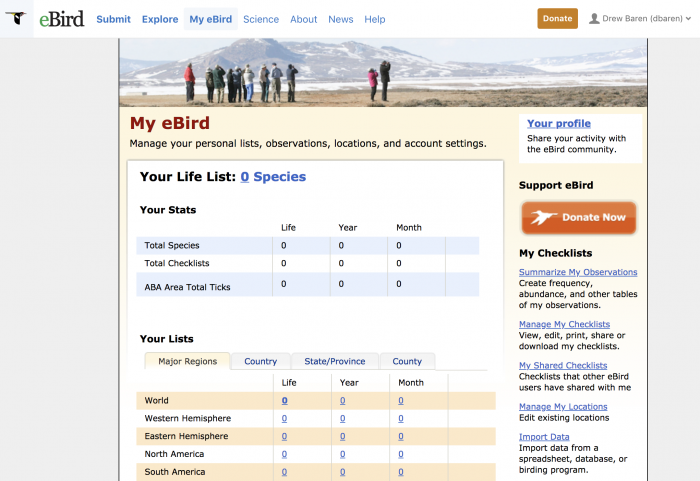
Merlin Bird ID
- iOS: 4.9/5 with 1.8K reviews / Android: 4/5 with 3.1K reviews
- Unique features
- Birds can be identified with a photo, with a good success rate
- Displays the "most likely" birds in your area based on location, time of year, etc.
- Observations
- Image-based identification is very cool, and users seem to think it works well
Audobon Bird Guide
- iOS: 4.5/5 with 624 ratings / Android: 4/5 with 2.4K ratings
- Unique features
- Integration with NatureShare's social network
- Observations
- Definitely old-looking, with many slow web-based views
- They used to have apps for mammals, wildflowers, and trees, but not anymore
iBird Pro
- iOS: 4.5/5 with 255 ratings / Android: 4.5/5 with 4.6K ratings
- Unique features
- Artwork includes juvenile males and females without swiping for more
- Observations
- Users report some sluggishness
- Unique filter options (by head patten, breast color)
- Search by song (somehow)
- Optimized for tablets with large artwork
Pencil and paper
- A seemingly common approach, paired with a book of native species
- A spreadsheet with an alphabetical list of bird names is seen in some videos
- Only bird-watchers familiar with all native species would be familiar enough to tally based on name alone
- No battery power necessary, which could be useful in very cold temperatures
User research
Interviews and field study
There are a many things that I'd like to learn from first-time and veteran birders that would help guide the new app's functionality and user interface. In addition to casually interviewing birders and/or holding focus groups, I'd also try to observe them during a count to see how effective their current bird-counting methods are and whether an app could help in some way.
- Demographics
- What is the age breakdown of birders?
- How many years have they participated in the CBC?
- CBC experience
- What is their favorite thing about the CBC?
- What is their least favorite thing about the CBC? (aside from the weather)
- Do they have a "role" during the CBC? Spotter? Identifier? Photographer? Navigation?
- Counting
- What counting method do they currently use? Why do they prefer it?
- What do they find difficult with their method? Can they imagine ways in which bird counting could be improved?
- How do they identify birds that you aren't familiar with? Do they search for birds by looking for specific features (i.e. red neck, size, etc.)?
- Technical familiarity
- Do they consider themselves adept at using iPhone and/or Android apps?
- Have they ever tried one of the many bird counting apps available? What did they like or dislike about them?
- Do you use any accessibility features of their phone? Larger text?
- Thoughts on a potential app
- If an app existed, what would they want it to be capable of?
- What features would be most important to them?
- Counting birds, looking them up via search, messaging with their group, learning more about certain birds, uploading photos of birds, etc.
Personas
- Kids
- Low expertise
- Adept at tracking movement, looking up, noticing colors and small details
- Capable of using (straightforward) apps
- May enjoy having the "recorder" job in the group
- Error detection and correction may be difficult
- Adults
- Low to high expertise
- Depending on age, just as capable as kids or older adults at noticing and ID'ing
- Likely capable of learning straightforward apps
- Able to notice and correct errors
- Older adults
- Possibly the most common persona
- Low to high expertise, likely leaning toward high
- Capable of ID'ing on sight or based on distinguishing features
- Capable of learning straightforward interfaces, if willing
- Common characteristics:
- They all enjoy bird-watching, or at least the idea of it for one year
Takeaways
- Audobon as a client
- Not small at all. A multi-million dollar organization with plans to invest in their technology, website, and apps.
- Intent on solidifying their brand across mediums and providing "best-in-class" experiences to birders
- They run their own social network, NatureShare, and used to make guides for mammals and other categories too
- CBC rules
- Groups must follow pre-defined routes
- Feed watchers and nighttime "owlers" are entirely separate data pools from the daytime birders who walk along the route. Their data is kept entirely separate.
- Walkers do not separate birds that they happen to see at feeders while on their path
- The start time of "owling" is nebulous, but intended to be an intentionally separate expedition
- What to expect
- Only ~100 bird species are typically in a circle at once, 250 max
- Remaining unkowns
- When does "birding" end and "owling" begin? The cutoff is midnight, and owls are usually encountered at night, but the CBC asks people to keep these checklists entirely separate.
- Is it definitely the case that fielders don't have to separate out observations they see at feeders, so long as they don't stick around them for long?
Assumptions
Without a Think Session with the client, I need to make a few assumptions before beginning the design process.
- Time is tight
- Basic functionality needs to be ready by October in time for CBC 2018
- The iPad is not a priority
- The lack of cellular connectivity and GPS makes the iPad less ideal
- The app should be extendable
- Not a one-trick pony; eventually it'll include more of Audobon's data and features to become the go-to app for birders, and maybe Think Company will help design them
- Responsive design for future iOS devices and potentially Android devices
- It has to be an iOS app
- An offline web app might suit their needs better, but I don't have enough information and the technology is still new, with limitations
- One person is typically the "recorder" at a time
- Not dealing with creating teams/groups at this time with synchronized data
- It should be newcomer-friendly
Feature requirements
Join a count group
- Requires online communication infrastructure with the circle leader
- Could have a social component to it. Seeing and chatting with other birders during that month.
- Could also be a unidirectional way for birders to get notifications from the circle leader
Enable the user to record:
- Hours spent watching/listening
- Automatic by session start/end
- Record all miles traveled along route
- Automatic using GPS, editable at the end
- Record each mode of transport, # of hours in that, and miles traveled
- Record hours watching at feeders separately from any field birding
- Record hours and miles "owling" separately from field birding
Diverge
- How might we?
- Organize home/nav?
- Standard nav bar
- News
- Blog posts, web content
- Feed
- The social network-esque element, with images of birds from friends and whatever, Audobon's NatureShare
- Sessions
- The CBC is a thing that appear at the top sometimes, otherwise they can do sessions throughout the year or whenever
- Profile
- Search
- Page allows you to search by photo ID
- By name
- By size/type/etc
- Can be accessed at any time
- Hamburger menu
- Swipe-able top menu
- Standard nav bar
- Size comparison. Maybe compare to a milk quart.
- Allow or don't allow retroactive adjustments?
- Show an active timer to remind them to turn it off
- Sessions should be called "sessions" rather than checklists.
- Recording interface
- One screen without scrolling
- Search interface
- What if they could quickly filter by tag? Like Fantastical. Brown... small... yellow... swimming/water... owl...
- Organize home/nav?
- Accessibility considerations
- Older audience, which means higher likelihood of accessibility feature use
- Accessibility audit
- Grayscale
- Reduce motion
-
Technical considerations
- How to prevent junk data? Spam? Especially without an account system?
- Artifacts
- Basic, quick, extremely rough sketches or small components
Prototype
Concept: An app that isn't just CBC-specific and used for 2 weeks, but is useful year-round.

